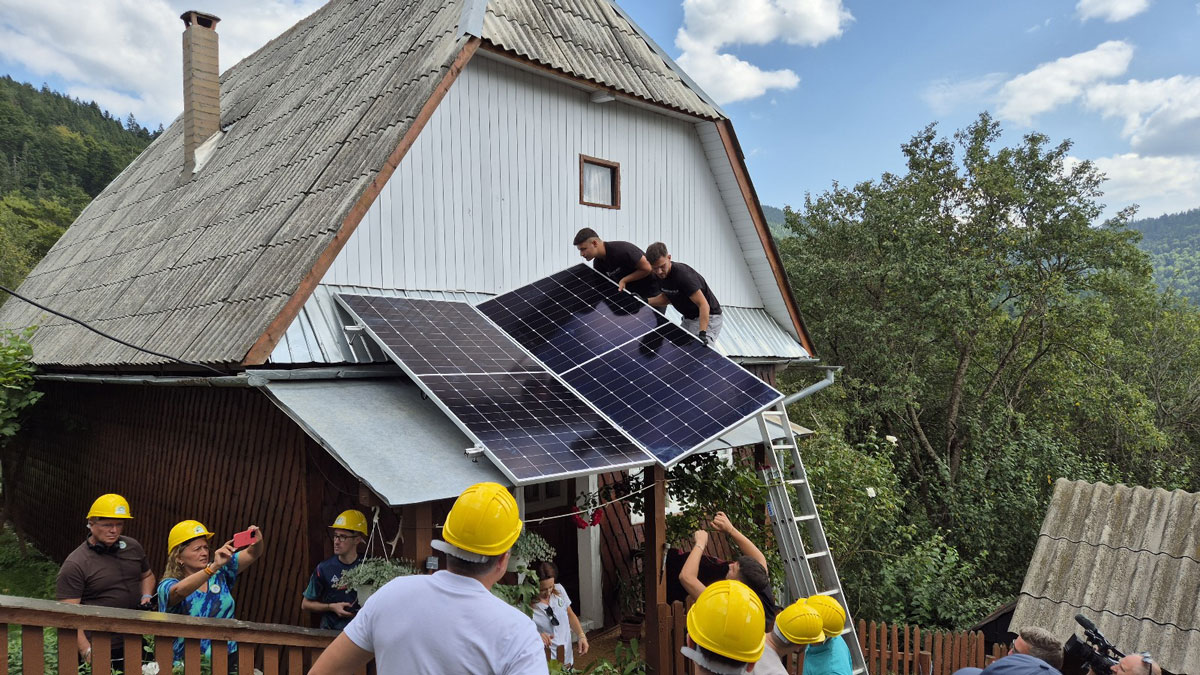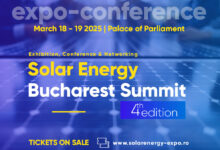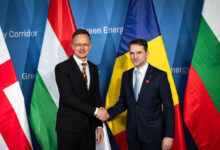AEI: ‘Energy for Life’ Program in Romania Goes On
The Intelligent Energy Association (AEI) has implemented the seventh edition of the ‘Energy for Life’ program, a step towards the goal of ‘Zero homes without electricity’. At the end of August, for nine houses in the village of Peste Valea Bistrii, belonging to the town of Campeni (Alba County), which have never been connected to the electricity grid, the difference between dark and light, when it gets dark, will be made by simply flipping a switch. This change is possible thanks to the installation of photovoltaic panels as part of the ‘Energy for Life’ program.
Campeni is documented since 1587. By a document issued by Sigismund Bathory, Prince of Transylvania, Nicolae Filimon from Campeni was allowed to build a mill at the Abrud river’s spill into the Aries. After the year 1649, Campeni became capital of the upper mountain domain, with the villages Bistra, Albac, and Vidra.
The town is known not only for the beauty of its landscape, but also for the personalities who have marked the history of Romanians, such as Horea, Closca and Crisan, leaders of the 1784 uprising, and Avram Iancu, who made a significant contribution to the 1848 Revolution.
On the Josephine Map of Transylvania of 1769-1773, the locality appears under the name ‘Topanfálva’. About 0.5 km to the east of Campeni, the map shows a site of buddle gold diggers (‘Gold Wäscherei’) in the alluvial deposits of the Aries. Along a nearby tributary valley to the right of the Aries, there are numerous gold-rich ore-processing stamp mills (‘Stampf Mühlen’).
In the middle of the 18th century, Campeni had 5,400 inhabitants, being the most populated mountain locality in Transylvania, and having even more inhabitants than Alba Iulia and Targu Mures.
Partnership for Combating Energy Poverty
In November 2023, the Intelligent Energy Association concluded with the Romanian Ministry of Energy the ‘Partnership for Combating Energy Poverty’, with the aim of achieving the goal of eradicating extreme energy poverty in Romania. With the support of the institution, within the framework of the partnership, an inventory of dwellings not connected to the electricity grid in Romania was carried out and the ‘National Electronic Register of Households without Electricity in Romania’ (RENGEER) was established, which revealed a number of 5,494 households without electricity, inhabited by 11,611 people, of which 4,777 are under 18 years of age.
The worrying fact is that 87% of houses without electricity do not have a cadaster, which makes it difficult to address the institutional approach to solving this problem; 64% of people living in houses without electricity have estimated incomes below the minimum income per person and household in Romania, so even connecting them to a distribution network would make it difficult to pay for the electricity consumed, in 53% of cases access to buildings without electricity being difficult, and for 10% there are no access roads.
Following this inventory, the Intelligent Energy Association proposed the development of the following directions in order to eradicate extreme energy poverty and reach the goal of zero homes permanently inhabited without electricity:
- Energy for Life – social responsibility programs to enable the electrification of hard-to-reach homes with no access roads and unattractive to be electrified commercially through specific programs
- Extension of feasible electricity distribution networks – obligation imposed on distribution system operators in the fifth regulatory period
- Green House for Energy Poverty
The establishment of the ‘National Electronic Register of Households without Electricity in Romania’ is an important step towards the goal of zero homes permanently inhabited without electricity, as it is the starting point for both the development of public policies on reducing extreme energy poverty in our country, and for undertaking actions to effectively reduce this phenomenon such as the ‘Energy for Life’ project.
Analysing how the situation of permanently inhabited buildings without electricity has evolved between 2017 and 2024 in Alba County, the following can be observed:
- 16% of non-electrified buildings have been electrified in the last seven years
- 45% of the buildings without electricity have been abandoned/deserted/destroyed in the last seven years
- 74% of people died/left their homes in the last seven years
- The average age of people living in non-electrified homes has risen from 67 to 74 in the last seven years
“Lack of access to energy is a problem we face in remote mountain areas. Thousands of families live in the dark, without the possibility of having a fridge plugged in, a TV or simply turning on a light bulb. Since the beginning of my mandate, I have supported this project, which is a gesture of solidarity and an opportunity to help improve the lives of parents and children. We, at the Ministry of Energy, remain committed to ensuring energy for every Romanian, which is why, on September 29, the Ministry is organizing the first ever Energy Cross – Energy for All, a charity event, where all the money raised will be donated to the ‘Energy for Life’ cause,” said Energy Minister Sebastian Burduja.
Alba County Council adheres to the goal of zero homes permanently inhabited without electricity. This goal contributes to the public policies of Alba County Council regarding the depopulation of mountain areas in Alba County. Since 2007 there has been a constant concern in providing energy to the entire county by developing electricity grids, as well as realizing/supporting independent projects for electrification of areas and houses using renewable energy sources. Particular attention has been paid to non-electrified housing, with more than 100 remote houses benefiting from the installation of photovoltaic energy production systems. Program such as ‘Energy for Life’ are projects that raise awareness of energy poverty and underpin coherent public policies in the field of energy. We welcome and support the efforts of the Intelligent Energy Association in the field of electricity,” said Alba County Council President Ion Dumitrel.
“The Intelligent Energy Association will continue to implement new stages of the ‘Energy for Life’ program and to electrify households in remote areas with no chance of being connected to the electricity grid in the near future by installing photovoltaic panels. In all the seven phases carried out in the four years since the beginning of this project, civil society has been the one that has contributed to the electrification of these households, and I believe that we have demonstrated that there can be a good collaboration between companies, NGOs and state authorities that can lead to solving problems of national interest. One of the greatest achievements of the ‘Energy for Life’ project, in addition to electrifying the beneficiary houses, has been to raise awareness of extreme energy poverty in Romania and to create a strong community that has supported our approach and become ambassadors of our efforts to achieve the goal of zero homes permanently inhabited without electricity,” said Monica David, Vice President, Intelligent Energy Association, ‘Energy for Life’ project Coordinator.
“We are pleased to continue our collaboration with the Intelligent Energy Association within the ‘Energy for Life’ project and to actively contribute to Romania’s sustainable development. The second stage of the ‘Energy for Life’ project, fully supported by Electrica Furnizare, which consisted in installing photovoltaic panels on five houses in the Harghita Mountains, convinced us that we have partners who share the same values. That is why Electrica Furnizare is joining the Intelligent Energy Association in this new endeavour in the village of Peste Valea Bistrii, where five families will benefit for the first time from electricity in their homes. We again thank the representatives of the association for their initiative, and we assure them that they will always find a reliable partner in us for such projects,” said Darius Dumitru Mesca, CEO of Electrica Furnizare.
“I underline our strong commitment to supporting the ‘Energy for Life’ project. For us, this project is not just a social initiative, but an essential objective that contributes directly to eradicating energy poverty in Romania. It is an honour, but also a responsibility for Hidroelectrica, the country’s most valuable company, to join and support a project of national importance. We believe that access to electricity is a fundamental right, and our involvement in ‘Energy for Life’ reflects our values and our mission to bring light not only literally, but also figuratively, into the lives of those who need it most. We will continue to support this project and work closely with all stakeholders to make this vision a reality. We are convinced that together we can build a brighter future for Romania,” said Karoly Borbely, CEO of Hidroelectrica.
‘Energy for Life’ was launched in the summer of 2021 to raise the alarm on extreme energy poverty in Romania. The project enjoyed a strong echo both in the media and among companies, and quickly coalesced a community of support that made its implementation possible. Following the conclusion of the Partnership for Combating Energy Poverty in Romania between the Intelligent Energy Association and the Ministry of Energy in the fall of 2023, the ‘Energy for Life’ project will be implemented under the umbrella of this agreement.
In the last four years of activity, the Intelligent Energy Association has electrified 51 buildings in 25 localities in five counties.
The seventh edition of ‘Energy for Life’ was made possible thanks to the support of project partners: Filip & Company, Hidroelectrica, Electrica Furnizare, Design Proiect and EM360 Studio. Media partners: Economistul, Financial Intelligence, The Diplomat, Invest Energy, Focus Energetic, Energy Industry Review, Energy Center, NewsEnergy, Energy Magazine, Spot Media, Club Economic and Romania Durabila.







